9.1: Evaluate Exponential Expressions and Graph Basic Exponential Equations
- Page ID
- 66384
By the end of this section, you will be able to:
- Graph basic exponential equations
- Solve exponential equations
- Use exponential models in applications
Before you get started, take this readiness quiz.
- Simplify: \(\left(\dfrac{x^{3}}{x^{2}}\right)\).
- Evaluate: a. \(2^{0}\) b. \(\left(\dfrac{1}{3}\right)^{0}\).
- Evaluate: a. \(2^{−1}\) b. \(\left(\dfrac{1}{3}\right)^{-1}\).
Basic Exponential Expressions
The expressions we have studied so far do not give us a model for many naturally occurring phenomena. From the growth of populations and the spread of viruses to radioactive decay and compounding interest, the models are very different from what we have studied so far. These models involve exponential expressions.
An exponential expression is an expression of the form \(a^{x}\) where \(a>0\) and \(a≠1\).
An exponential expression, where \(a>0\) and \(a≠1\), is an expression of the form
\(a^{x}\)
Notice that in this expression, the variable is the exponent. In our expressions so far, the variables were the base.
2.png?revision=1)
Our definition says \(a≠1\). If we let \(a=1\), then \(a^{x}\) becomes \(1^{x}\). But we know \(1^{x}=1\) for all real numbers.
Our definition also says \(a>0\). If we let a base be negative, say \(−4\), then \((−4)^{x}\) is not a real number when \(x=\dfrac{1}{2}\).
In fact, \((−4)^{x}\) would not be a real number any time \(x\) is a fraction with an even denominator. So our definition requires \(a>0\).
Graphing a few exponential equations will be illuminating.
On the same coordinate system graph \(y=2^{x}\) and \(y=3^{x}\).
Solution:
We will use point plotting to graph the equations.
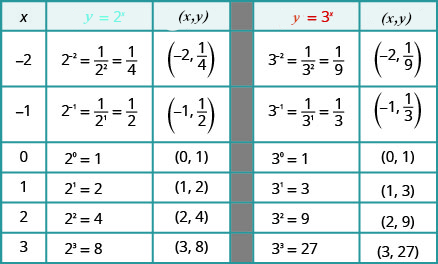
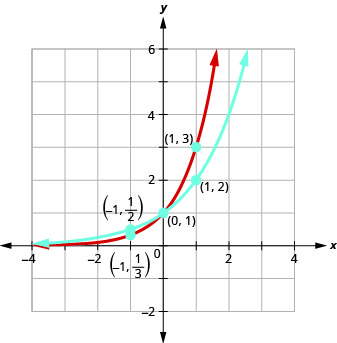
Graph: \(y=4^{x}\).
- Answer
-
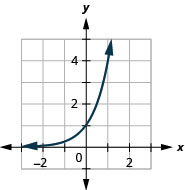
Graph: \(y=5^{x}\)
- Answer
-
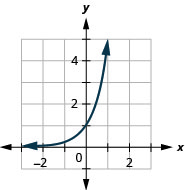
If we look at the graphs from the previous Example 9.1.2 and Try Its 9.1.3 and 9.1.4, we can identify some of the properties of exponential expressions.
The graphs of \(y=2^{x}\) and \(y=3^{x}\), as well as the graphs of \(y=4^{x}\) and \(y=5^{x}\), all have the same basic shape. This is the shape we expect of the graph of \(y=a^x\) where \(a>1\).
We notice, that for each equation, the graph contains the point \((0,1)\). This make sense because \(a^{0}=1\) for any \(a\).
The graph of each equation, \(y=a^{x}\) also contains the point \((1,a)\). The graph of \(y=2^{x}\) contained \((1,2)\) and the graph of \(y=3^{x}\) contained \((1,3)\). This makes sense as \(a^{1}=a\).
Notice too, the graph of each equation \(y=a^{x}\) also contains the point \((−1,\dfrac{1}{a})\). The graph of \(y=2^{x}\) contained \((−1,\dfrac{1}{2})\) and the graph of \(y=3^{x}\) contained \((−1,\dfrac{1}{3})\).This makes sense as \(a^{−1}=\dfrac{1}{a}\).
Notice, that the expression \(a^x\), \(a>1\) makes sense for any value of \(x\).
And, look at each graph. The graph never hits the \(x\)-axis which means \(a^x>0\)
Whenever a graph of an equation approaches a line but never touches it, we call that line an asymptote. For the exponential equations we are looking at, the graph approaches the \(x\)-axis very closely but will never cross it, we call the line \(y=0\), the \(x\)-axis, a horizontal asymptote. Recognizing that these all have the asymptote \(y=0\) can be helpful when graphing.
The following graph summarizes the situation when \(a>1\).
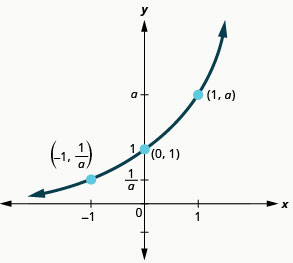
Our definition of an exponential expression \(a^{x}\) says \(a>0\), but the examples and discussion so far has been about equations where \(a>1\). What happens when \(0<a<1\) The next example will explore this possibility.
On the same coordinate system, graph \(y=\left(\dfrac{1}{2}\right)^{x}\) and \(y=\left(\dfrac{1}{3}\right)^{x}\).
Solution:
We will use point plotting to graph the equations.
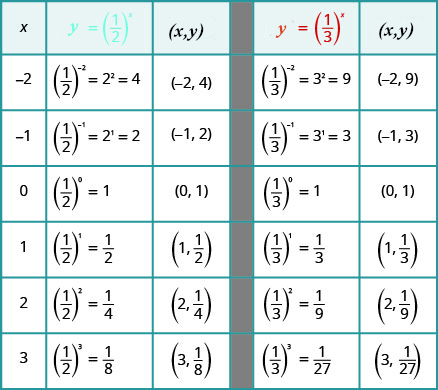
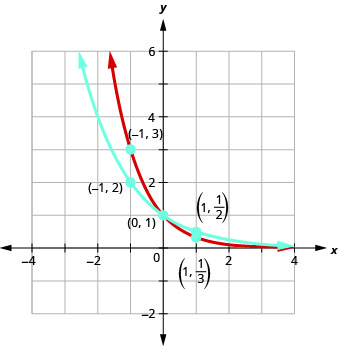
Graph: \(y=\left(\dfrac{1}{4}\right)^{x}\).
- Answer
-
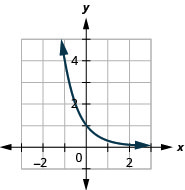
Graph: \(y=\left(\dfrac{1}{5}\right)^{x}\).
- Answer
-
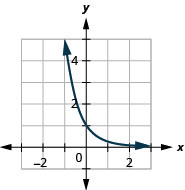
Now let’s look at the graphs from the previous Example 10.2.5 and Try Its 10.2.6 and 10.2.7 so we can now identify some of the properties of exponential expressions where \(0<a<1\).
The graphs of \(y=\left(\dfrac{1}{2}\right)^{x}\) and \(y=\left(\dfrac{1}{3}\right)^{x}\) as well as the graphs of \(y=\left(\dfrac{1}{4}\right)^{x}\) and \(y=\left(\dfrac{1}{5}\right)^{x}\) all have the same basic shape. While this is the shape we expect from an exponential equation of the form \(y=a^x\), where \(0<a<1\), the graphs go down from left to right while the previous graphs, when \(a>1\), went from up from left to right.
We notice that for each equation, the graph still contains the point \((0, 1)\). This make sense because \(a^{0}=1\) for any \(a\).
As before, the graph of each equation, \(f(x)=a^{x}\), also contains the point \((1,a)\). The graph of \(y=\left(\dfrac{1}{2}\right)^{x}\) contained \(\left(1, \dfrac{1}{2}\right)\) and the graph of \(y=\left(\dfrac{1}{3}\right)^{x}\) contained \(\left(1, \dfrac{1}{3}\right)\). This makes sense as \(a^{1}=a\).
Notice too that the graph of each equation, \(y=a^{x}\), also contains the point \(\left(-1, \dfrac{1}{a}\right)\). The graph of \(y=\left(\dfrac{1}{2}\right)^{x}\) contained \((−1,2)\) and the graph of \(y=\left(\dfrac{1}{3}\right)^{x}\) contained \((−1,3)\). This makes sense as \(a^{-1}=\dfrac{1}{a}\).
Notice, that the expression \(a^x\), \(0<a<1\) makes sense for any value of \(x\).
Again, the graph never hits the \(x\)-axis. The range is all positive numbers. We write the range in interval notation as \((0,∞)\).
We will summarize these properties in the chart below. Which also includes when \(a>1\).
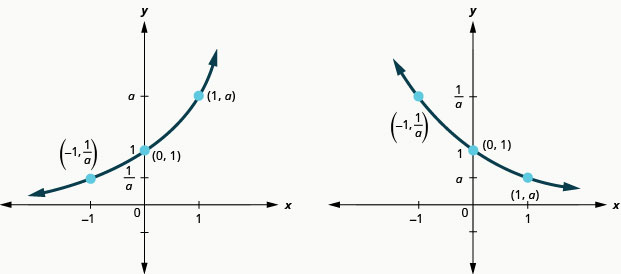
Natural Base \(e\)
In applications, it happens that different bases are convenient for writing relevant expressions. There is one number which is written "\(e\)" . We will not delve into the details of this number except to say that this number is irrational and
\(e \approx 2.718281827.\)
Most calculators will include this particular base on a button often labeled \(e^x\).
Let’s graph the equation \(y=e^{x}\) on the same coordinate system as \(y=2^{x}\) and \(y=3^{x}\).
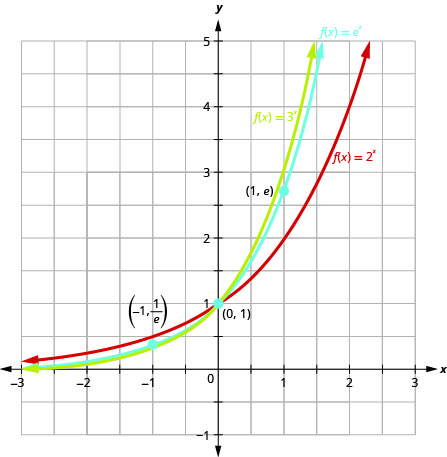
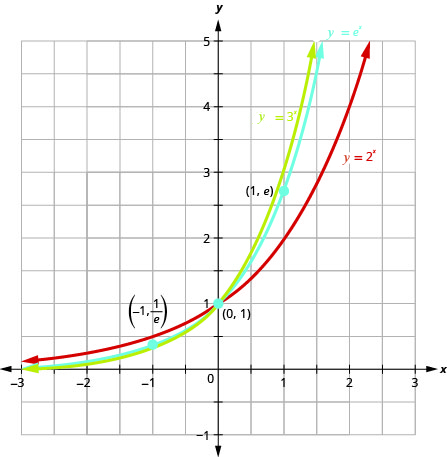
Notice that the graph of \(y=e^{x}\) is “between” the graphs of \(y=2^{x}\) and \(y=3^{x}\).Does this make sense as \(2<e<3\)?
Solve Exponential Equations
Equations that include an exponential expression \(a^{x}\) are called exponential equations. To solve them we use a property that says as long as \(a>0\) and \(a≠1\), if \(a^{x}=a^{y}\) then it is true that \(x=y\). In other words, in an exponential equation, if the bases are equal then the exponents are equal. To see why this is true consider the graph of \(y=2^x\) and see that if the two y-coordinates on the graph are the same, then the x-coordinates must also agree.
One-to-One Property of Exponential Equations
For \(a>0\) and \(a≠1\),
If \(a^{x}=a^{y}\), then \(x=y\).
To use this property, we must be certain that both sides of the equation are written with the same base.
Solve: \(3^{2 x-5}=27\).
Solution:
| Write both sides of the equation with the same base. | Since the left side has base \(3\), we write the right side with base \(3\). \(27=3^{3}\) | \(3^{2 x-5}=27\) \(3^{2 x-5}=3^{3}\) |
| Write a new equation by setting the exponents equal. | Since the bases are the same, the exponents must be equal. | \(2x-5=3\) |
| Solve the equation. |
Add \(5\) to each side. Divide by \(2\). |
\(\begin{aligned} 2 x &=8 \\ x &=4 \end{aligned}\) |
| Check the solution (to ensure there are no errors). | Substitute \(x=4\) into the original equation. | \(\begin{aligned} 3^{2 x-5} &=27 \\ 3^{2 \cdot \color{red}{4}\color{black}{-}5} & \stackrel{?}{=} 27 \\ 3^{3} &\stackrel{?}{=}27 \\ 27 &\stackrel{?}{=}27 \text{ True} \end{aligned}\) |
Solve: \(3^{3 x-2}=81\).
- Answer
-
\(x=2\)
Solve: \(7^{x-3}=7\).
- Answer
-
\(x=4\)
The steps are summarized below.
How to Solve an Exponential Equation
- Write both sides of the equation with the same base, if possible.
- Write a new equation by setting the exponents equal.
- Solve the equation.
- Check the solution to make sure no error has been made.
In the next example, we will use our properties on exponents.
Solve \(\dfrac{e^{x^{2}}}{e^{3}}=e^{2 x}\).
Solution:
| \(\dfrac{e^{x^{2}}}{e^{3}}=e^{2 x}\) | |
| Use the Property of Exponents: \(\dfrac{a^{m}}{a^{n}}=a^{m-n}\). | \(e^{x^{2}-3}=e^{2 x}\) |
| Write a new equation by setting the exponents equal. | \(x^{2}-3=2 x\) |
| Solve the equation. | |
| \((x-3)(x+1)=0\) | |
| \(x=3\) or \(x=-1\) | |
| Check the solutions. |
\(\begin{aligned} x=3& \quad x=-1\\ \dfrac{e^{x^2}}{e^3}{=}e^{2x}& \quad \quad \dfrac{e^{x^2}}{e^3}{=}e^{2x}\\ \dfrac{e^{3^2}}{e^3}\stackrel{?}{=}e^{2\cdot 3}& \quad \quad \dfrac{e^{(-1)^2}}{e^3}\stackrel{?}{=}e^{2\cdot(-1)}\\ \dfrac{e^9}{e^3}\stackrel{?}{=}e^6& \quad \quad \dfrac{e^1}{e^3}\stackrel{?}{=}e^{-2}\\e^6\stackrel{?}{=}e^6\text{ True}& \quad \quad e^{-2}\stackrel{?}{=}e^{-2}\text{ True}\end{aligned}\) The solutions are \(x=3\) and \(x=-1\). |
Solve: \(\dfrac{e^{x^{2}}}{e^{x}}=e^{2}\).
- Answer
-
\(x=-1, x=2\)
Solve: \(\dfrac{e^{x^{2}}}{e^{x}}=e^{6}\).
- Answer
-
\(x=-2, x=3\)
Use Exponential Models in Applications
Exponential equations model many situations. If you own a bank account, you have experienced the use of an exponential equation. There are two formulas that are used to determine the balance in the account when interest is earned. If a principal, \(P\), is invested at an interest rate, \(r\), for \(t\) years, the new balance, \(A\), will depend on how often the interest is compounded, i.e., how often the interest is calculated and then added to the new balance. If the interest is compounded \(n\) times a year we use the formula \(A=P\left(1+\dfrac{r}{n}\right)^{n t}\). If the interest is compounded continuously, we use the formula \(A=Pe^{rt}\). These are the formulas for compound interest.
Compound Interest is interest that accumulates on the interest earned.
The principal is the amount invested.
Interest is compounded when the interest is calculated and then added to the new balance.
For a principal, \(P\), invested at an interest rate, \(r\), for \(t\) years, the new balance, \(A\), is:
\(\begin{array}{ll}{A=P\left(1+\dfrac{r}{n}\right)^{n t}} & {\text { when compounded } n \text { times a year. }} \\ {A=P e^{r t}} & {\text { when continuously. }}\end{array}\)
To see why the first formula works, work out some examples by writing down how the compounding works in detail. As you work with the Interest formulas, it is often helpful to identify the values of the variables first and then substitute them into the formula.
A total of $\(10,000\) was invested in a college fund for a new grandchild. If the interest rate is \(5\)%, how much will be in the account in \(18\) years by each method of compounding?
- compound quarterly
- compound monthly
- compound continuously
Solution:
Identify the values of each variable in the formulas. Remember to express the percent as a decimal.
\(\begin{aligned} A &=? \\ P &=\$ 10,000 \\ r &=0.05 \\ t &=18 \text { years } \end{aligned}\)
a. For quarterly compounding, \(n=4\). There are \(4\) quarters in a year.
\(A=P\left(1+\dfrac{r}{n}\right)^{n t}\)
Substitute the values in the formula.
\(A=10,000\left(1+\dfrac{0.05}{4}\right)^{4 \cdot 18}\)
Compute the amount. Be careful to consider the order of operations as you enter the expression into your calculator.
\(A=\$ 24,459.20\)
b. For monthly compounding, \(n=12\).There are \(12\) months in a year.
\(A=P\left(1+\dfrac{r}{n}\right)^{n t}\)
Substitute the values in the formula.
\(A=10,000\left(1+\dfrac{0.05}{12}\right)^{12 \cdot 18}\)
Compute the amount.
\(A=\$ 24,550.08\)
c. For compounding continuously,
\(A=P e^{r t}\)
Substitute the values in the formula.
\(A=10,000 e^{0.05 \cdot 18}\)
Compute the amount.
\(A=\$ 24,596.03\)
Angela invested $\(15,000\) in a savings account. If the interest rate is \(4\)%, how much will be in the account in \(10\) years by each method of compounding?
- compound quarterly
- compound monthly
- compound continuously
- Answer
-
- $\(22,332.96\)
- $\(22,362.49\)
- $\(22,377.37\)
Allan invested $\(10,000\) in a mutual fund. If the interest rate is \(5\)%, how much will be in the account in \(15\) years by each method of compounding?
- compound quarterly
- compound monthly
- compound continuously
- Answer
-
- $\(21,071.81\)
- $\(21,137.04\)
- $\(21,170.00\)
Other topics that are modeled by exponential equations involve growth and decay. Both also use the formula \(A=Pe^{rt}\) we used for the growth of money. For growth and decay, generally we use \(A_{0}\), as the original amount instead of calling it \(P\), the principal. We see that exponential growth has a positive rate of growth and exponential decay has a negative rate of growth.
Exponential Growth and Decay
For an original amount, \(A_{0}\), that grows or decays at a rate, \(r\), for a certain time, \(t\), the final amount, \(A\), is:
\(A=A_{0} e^{r t}\)
Exponential growth is typically seen in the growth of populations of humans or animals or bacteria. Our next example looks at the growth of a virus.
Chris is a researcher at the Center for Disease Control and Prevention and he is trying to understand the behavior of a new and dangerous virus. He starts his experiment with \(100\) of the virus that grows at a rate of \(25\)% per hour. He will check on the virus in \(24\) hours. How many viruses will he find?
Solution:
Identify the values of each variable in the formulas. Be sure to put the percent in decimal form. Be sure the units match--the rate is per hour and the time is in hours.
\(\begin{aligned} A &=? \\ A_{0} &=100 \\ r &=0.25 / \text { hour } \\ t &=24 \text { hours } \end{aligned}\)
Substitute the values in the formula: \(A=A_{0} e^{r t}\).
\(A=100 e^{0.25 \cdot 24}\)
Compute the amount.
\(A=40,342.88\)
Round to the nearest whole virus.
\(A=40,343\)
The researcher will find \(40,343\) viruses.
Another researcher at the Center for Disease Control and Prevention, Lisa, is studying the growth of a bacteria. She starts his experiment with \(50\) of the bacteria that grows at a rate of \(15\)% per hour. He will check on the bacteria every \(8\) hours. How many bacteria will he find in \(8\) hours?
- Answer
-
She will find \(166\) bacteria.
Maria, a biologist is observing the growth pattern of a virus. She starts with \(100\) of the virus that grows at a rate of \(10\)% per hour. She will check on the virus in \(24\) hours. How many viruses will she find?
- Answer
-
She will find \(1,102\) viruses.
Key Concepts
- Properties of the Graph of \(y=a^{x}\):

- One-to-One Property of Exponential Equations:
For \(a>0\) and \(a≠1\), if \(a^x=a^y\) then \(x=y\). - How to Solve an Exponential Equation
- Write both sides of the equation with the same base, if possible.
- Write a new equation by setting the exponents equal.
- Solve the equation.
- Check the solution to ensure there are no errors.
- Compound Interest: For a principal, \(P\), invested at an interest rate, \(r\), for \(t\) years, the new balance, \(A\), is
\(\begin{array}{ll}{A=P\left(1+\dfrac{r}{n}\right)^{n t}} & {\text { when compounded } n \text { times a year. }} \\ {A=P e^{r t}} & {\text { when compounded continuously. }}\end{array}\) - Exponential Growth and Decay: For an original amount, \(A_{0}\) that grows or decays at a rate, \(r\), for a certain time \(t\), the final amount, \(A\), is \(A=A_{0}e^{rt}\).
Glossary
- asymptote
- A line which a graph of an equation approaches closely but never touches.
- exponential expression
- An exponential expression, where \(a>0\) and \(a≠1\), is an expression of the form \(a^{x}\).
- natural base
- The number \(e\) is an irrational number that appears in many applications. \(e≈2.718281827...\)
Practice Makes Perfect
In the following exercises, graph each exponential function.
- \(y=2^{x}\)
- \(y=3^{x}\)
- \(y=6^{x}\)
- \(y=7^{x}\)
- \(y=(1.5)^{x}\)
- \(y=(2.5)^{x}\)
- \(y=\left(\dfrac{1}{2}\right)^{x}\)
- \(y=\left(\dfrac{1}{3}\right)^{x}\)
- \(y=\left(\dfrac{1}{6}\right)^{x}\)
- \(y=\left(\dfrac{1}{7}\right)^{x}\)
- \(y=(0.4)^{x}\)
- \(y=(0.6)^{x}\)
- Answer
-
1.
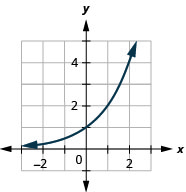
3.
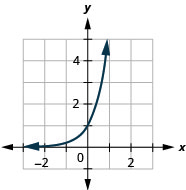
5.
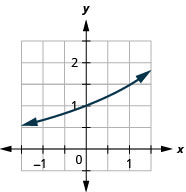
7.
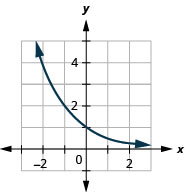
9.
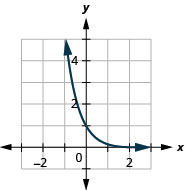
11.
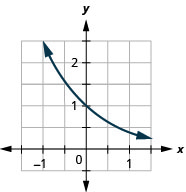
In the following exercises, solve each equation.
- \(2^{3 x-8}=16\)
- \(2^{2 x-3}=32\)
- \(3^{x+3}=9\)
- \(3^{x^{2}}=81\)
- \(4^{x^{2}}=4\)
- \(4^{x}=32\)
- \(4^{x+2}=64\)
- \(4^{x+3}=16\)
- \(2^{x^{2}+2 x}=\dfrac{1}{2}\)
- \(3^{x^{2}-2 x}=\dfrac{1}{3}\)
- \(e^{3 x} \cdot e^{4}=e^{10}\)
- \(e^{2 x} \cdot e^{3}=e^{9}\)
- \(\dfrac{e^{x^{2}}}{e^{2}}=e^{x}\)
- \(\dfrac{e^{x^{2}}}{e^{3}}=e^{2 x}\)
- Answer
-
13. \(x=4\)
15. \(x=-1\)
17. \(x=-1, x=1\)
19. \(x=1\)
21. \(x=-1\)
23. \(x=2\)
25. \(x=-1, x=2\)
In the following exercises, use an exponential model to solve.
- Edgar accumulated $\(5,000\) in credit card debt. If the interest rate is \(20\)% per year, and he does not make any payments for \(2\) years, how much will he owe on this debt in \(2\) years by each method of compounding?
- compound quarterly
- compound monthly
- compound continuously
- Cynthia invested $\(12,000\) in a savings account. If the interest rate is \(6\)%, how much will be in the account in \(10\) years by each method of compounding?
- compound quarterly
- compound monthly
- compound continuously
- Rochelle deposits $\(5,000\) in an IRA. What will be the value of her investment in \(25\) years if the investment is earning \(8\)% per year and is compounded continuously?
- Nazerhy deposits $\(8,000\) in a certificate of deposit. The annual interest rate is \(6\)% and the interest will be compounded quarterly. How much will the certificate be worth in \(10\) years?
- A researcher at the Center for Disease Control and Prevention is studying the growth of a bacteria. He starts his experiment with \(100\) of the bacteria that grows at a rate of \(6\)% per hour. He will check on the bacteria every \(8\) hours. How many bacteria will he find in \(8\) hours?
- A biologist is observing the growth pattern of a virus. She starts with \(50\) of the virus that grows at a rate of \(20\)% per hour. She will check on the virus in \(24\) hours. How many viruses will she find?
- In the last ten years the population of Indonesia has grown at a rate of \(1.12\)% per year to \(258,316,051\). If this rate continues, what will be the population in \(10\) more years?
- In the last ten years the population of Brazil has grown at a rate of \(0.9\)% per year to \(205,823,665\). If this rate continues, what will be the population in \(10\) more years?
- Answer
-
27.
- $\(7,387.28\)
- $\(7,434.57\)
- $\(7,459.12\)
29. $\(36,945.28\)
31. \(223\) bacteria
33. \(288,929,825\)
- Explain how you can distinguish between exponential expressions and polynomial expressions.
- Compare and contrast the graphs of \(y=x^{2}\) and \(y=2^{x}\).
- What happens to an exponential function as the values of \(x\) decreases? Will the graph ever cross the \(x\)-axis? Explain.
- Answer
-
35. Answers will vary
37. Answers will vary
Self Check
a. After completing the exercises, use this checklist to evaluate your mastery of the objectives of this section.
| I can... | Confidently | With some help | No-I don't get it! |
|---|---|---|---|
| evaluate exponential expressions | |||
| graph basic exponential equations | |||
| solve exponential equations | |||
| Use exponential models in applications |
b. After reviewing this checklist, what will you do to become confident for all objectives?


